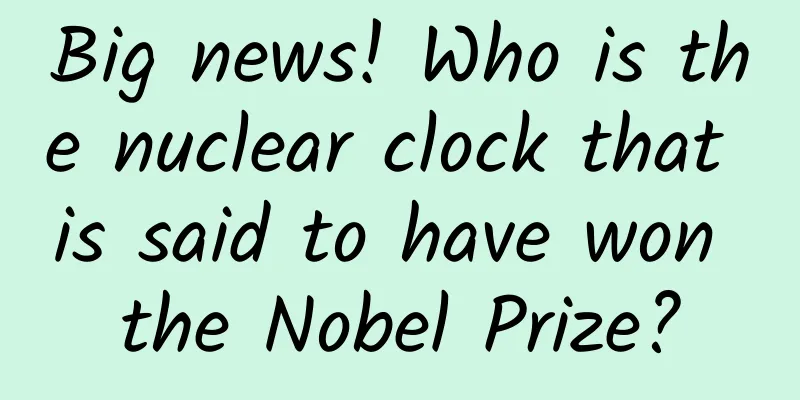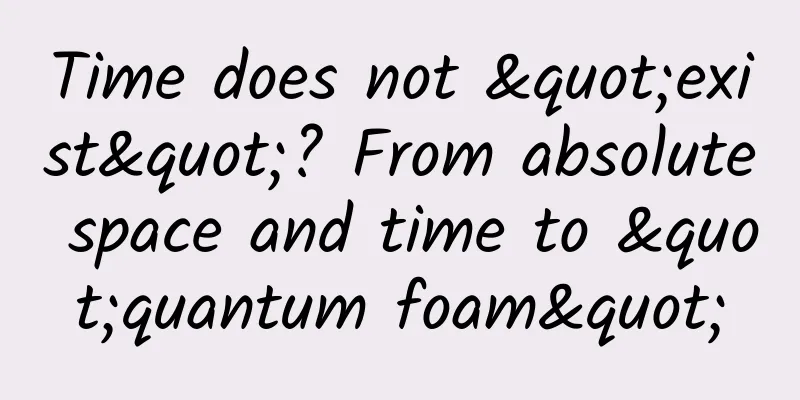Big news! Who is the nuclear clock that is said to have won the Nobel Prize?

|
Produced by: Science Popularization China Author: Li Huadong (PhD in Theoretical Physics) Producer: China Science Expo Editor's note: In order to understand the latest developments in cutting-edge science and technology, the China Science Popularization Frontier Science Project has launched a series of articles titled "Understanding Top Science Journals", which selects outstanding papers from authoritative journals and interprets them in plain language as soon as possible. Let us broaden our scientific horizons and enjoy the fun of science through the window of top journals. Perhaps, apart from physicists, no one else would be so obsessed with defining "one second". On September 4, 2024, Nature magazine published a cover paper titled "Nuclear transitions of thorium-229m isomers and frequency ratios of strontium-87 atomic clocks." Nature cover (Image source: Nature) On the same day, the official website of Science magazine published a commentary article, calling the achievement "a breakthrough that is expected to bring ultra-precision nuclear clocks into a new era." Some netizens even claimed that with this achievement, the author of the paper, Ye Jun (team) from the University of Colorado, is expected to win the Nobel Prize in Physics in the future. So, what kind of research is it that has been recommended by two top journals, Nature and Science? Who is this "nuclear clock"? And what difference can it make to the definition of "one second"? How to define "one second", 1/86400 of a day? In the eyes of the public, one second is the time it takes for the second hand on a clock to pass through one grid. If it passes through 60 grids, one minute has passed; if it passes through 3,600 grids, one hour has passed; if it passes through 86,400 grids, one day has passed. Everything seems so natural, because this is how the Earth rotates and revolves - when a day passes, the sun will be facing the same place again - 86,400 seconds is just that long. Since the Earth is revolving around the Sun, the location A that is directly exposed to the Sun on that day has to wait for the Earth to rotate a certain angle (4 minutes) before it can be directly exposed to the Sun again after the Earth rotates once (23 hours and 56 minutes, a sidereal day). The total time is 24 hours (a solar day). (Image source: Renaissance Universal) But the problem is that due to factors such as tidal effects, changes in the sun's mass, and the gravity of other celestial bodies, the changes in the Earth's rotation and revolution periods, although extremely small, do exist. The "length of a second" that people define in terms of "days" does not seem to always be that long. So, in the 20th century, riding on the east wind of science moving from the macro to the micro, and from the classical to the quantum, physicists discovered that there is a super "clock" in nature that is far more stable than the movement of celestial bodies. Although the second defined by it - 9,192,631,770 times the period of the electromagnetic wave radiated when a cesium-133 atom transitions between two hyperfine energy levels in its ground state - is so difficult for ordinary people to understand that it is almost like "bird language", it has become a powerful tool for physicists to study the properties of space and time. After all, who wouldn't want to measure the gravitational redshift caused by the Earth at a very close distance? [Reading Tips: Gravitational Redshift Phenomenon] Gravitational redshift refers to the phenomenon that due to the existence of a gravitational field, the frequency of light or other electromagnetic radiation emitted from a gravitational field decreases when it is far away from the gravitational field, and the wavelength becomes longer, thus moving to the red end of the spectrum. It is one of the phenomena predicted by Einstein's general theory of relativity. If gravitational redshift can be observed, it will be a strong verification of general relativity. Because the Earth's gravitational field is relatively weak, the redshift effect is very small at a short distance. Under laboratory conditions, even very precise instruments are difficult to detect such tiny changes. Therefore, this is also a problem that many scientists are trying to solve. Atomic clocks and optical clocks are more accurate! But are they the most accurate? On February 17, 2022, the cover paper of Nature magazine, Resolving the gravitational redshift across a millimetre-scale atomic sample, stated that even if the height difference is only 1 mm, the difference in the passage of time can be measured. Nature cover The paper's author, Ye Jun's team from the University of Colorado, measured the transition frequency of a 1 mm thick strontium-87 cluster (about 100,000 atoms) and found that the transition frequency of the top and bottom atoms differed by about one trillionth of a part. This value means that 300 billion years from now, the atoms at the top will experience one second more than those at the bottom. This is the first time that humans have verified the gravitational redshift effect predicted by general relativity on a millimeter scale. The higher the atom is, the more severe the gravitational redshift is, and the longer/faster the time it takes (Image source: Wikipedia) The premise of all this is that the definition of the unit time, that is, "one second", is precise enough to allow us to distinguish the smallest time difference. As mentioned earlier, 9,192,631,770 times the period of the electromagnetic wave (microwave) radiated when the cesium-133 atom transitions between two hyperfine energy levels is one second. Based on the transition frequency of cesium-133, the strontium-87 used by Ye Jun's team can also be used for definition: One second is 429,228,004,229,873.4 times the period of the electromagnetic wave (visible light) radiated by the strontium-87 atom when it transitions between the 5s² ¹S₀ and 5s5p ³P₀ energy levels. This seems more complicated, but you don't need to worry too much about it. You just need to know that when electrons in atoms transition between different energy levels, they release electromagnetic waves. The frequency of electromagnetic waves is only related to the energy levels of the initial and final states of the transition. It is extremely stable, so it has become the first choice for physicists to use for timing. When electrons jump between different energy levels, they release electromagnetic waves of a certain frequency (energy). (Image source: Wikipedia) When the electromagnetic waves released by the atoms used in the timing device during transition are in the microwave band, it is an atomic clock; when the electromagnetic waves released during the transition are in the visible light band, it is an optical clock. Theoretically, optical clocks are more accurate than atomic clocks because the electromagnetic waves they emit have higher frequencies and narrower linewidths. High frequency means that more cycles can be measured per unit time, so the time taken for a single cycle can be determined more accurately. Narrow line width means less uncertainty in frequency, further improving the accuracy of the defined time. Illustration of period, frequency, and bandwidth It seems that even clocks at the same quantum scale can perform differently, not to mention that external factors such as magnetic fields, temperature, and vibration will amplify these differences. So, is there a more stable tool that is less sensitive to the outside world and can define "one second" more accurately? Yes! That is the nuclear clock. What is the principle of nuclear clock? As early as 1996, Russian physicist Eugene V. Tkalya proposed the idea of using "nuclear excitation" as a highly stable light source for timing. The so-called "nuclear excitation" is similar to the process in which electrons outside the nucleus jump to a higher energy level after absorbing energy, making the atom in an excited state. The atomic nucleus itself may also be in a higher energy state after absorbing specific energy. The stimulated transition process of electrons outside the nucleus (Image source: University of Rochester) Similarly, atomic nuclei will also radiate electromagnetic waves of a certain energy during the stimulated transition process. Since the stimulated radiation of atoms can be used to make atomic clocks and optical clocks, why can't the stimulated radiation of atomic nuclei be used to make a "nuclear clock"? Based on this idea, scientists began to study the feasibility of nuclear clocks. Gradually, they found that unlike cesium-133 and strontium-87, which are commonly used in atomic clocks and optical clocks, only thorium-229 nuclei can be used to make nuclear clocks. Because apart from it, the energy of transitions between different energy levels of other atomic nuclei is too high, resulting in the frequency of the radiated electromagnetic waves being too high to be measured for timing. The "Thorium-229m isomer" mentioned at the beginning of this article and in the paper of Ye Jun's team is an excited state of the thorium-229 nucleus. The energy level difference between it and the ground state is about 8.3557 eV, and the corresponding electromagnetic wave radiated is in the ultraviolet band. The lowest energy level difference of the thorium-229 nucleus (Image source: Physics.net) This is a higher frequency than the electromagnetic waves radiated in atomic clocks and optical clocks, but fortunately it is within the range that the instrument can measure. Therefore, in theory, if it is used to measure time, it will be able to achieve higher accuracy. In addition, compared with the extranuclear electrons in the atom, the nucleus itself is less affected by external factors such as magnetic fields and thermal radiation. This is like a person holding an umbrella on a windy and rainy day. When a gust of wind blows (external disturbance), the umbrella (electron) must shake more than the person (nucleus). Atomic clocks experience timing errors (frequency changes) after being exposed to thermal radiation (red beam) (Image source: German National Metrology Institute) Therefore, compared with atomic clocks and optical clocks (which need to be placed in a vacuum and ultra-low temperature environment close to absolute zero), nuclear clocks have lower environmental requirements and are more stable. So far, we have learned about the important value of nuclear clocks in the field of precision measurement. But how powerful are they? Theoretically, its accuracy can reach 10⁻¹⁹, which is about 10 times more accurate than the best optical clock currently available. What does that mean? Not a second off in 300 billion years! Major breakthrough: Is the nuclear clock finally coming? In the experiment of Ye Jun's team, thorium-229 was doped into calcium fluoride (CaF₂) single crystals with a doping concentration of 5×10¹⁸/cm³, which means that each cubic centimeter of the crystal contains 500 trillion thorium-229 atoms. To excite the thorium-229 atoms, they irradiated the crystal with a vacuum ultraviolet laser (VUV laser). When fluorescence flashed, it meant that the excitation was successful (entering the thorium-229m state). After that, the emitted fluorescent photons are collected using filters (to filter out background light) and photomultiplier tubes, and their frequencies are measured. Schematic diagram and actual photos of the experimental device (Image source: Ye Jun's team paper) The entire experiment was controlled at 151K, which is about -122°C. Obviously, this is much easier to operate than the absolute zero required for atomic clocks and optical clocks, which is about -273°C. Finally, Ye Jun's team measured the radiation frequency of the thorium-229 nuclear transition to be 2 020 407 384 335(2) kHz, and its ratio to the radiation frequency of the strontium-87 atomic transition to be approximately 4.7. This means that if we still use the atomic transition frequency of cesium-133 as the benchmark, but define one second based on the nuclear transition frequency of thorium-229, we have: One second is 2,020,407,384,335,000 times the period of the electromagnetic wave (ultraviolet light) radiated by the thorium-229 nucleus when it transitions between the thorium-229m and thorium-229 ground states! Of course, this result still has a lot of errors and cannot be used for official definitions. But even so, compared with the past, Ye Jun's team has improved the accuracy of the nuclear clock by about 6 orders of magnitude, reaching the level of 10⁻¹². Therefore, although we have not yet reached the end point predicted by the theory - as Science magazine said, the achievements of Ye Jun's team are expected to bring ultra-precision nuclear clocks into a new era, it is "hopeful" rather than "already", and regardless of whether he will be favored by the Nobel Prize in the future - it can still be said to be a big step forward! end The clocks we use at home are completely sufficient even if they have an error of 1 second in two days; the rubidium atomic clocks on the Beidou satellites have an error of 1 second in 3 million years, which is also accurate enough. For ordinary people, whether it is a nuclear clock, an optical clock or an atomic clock, there is really no difference. Until the earth dies and the galaxy collapses, this "watch" is still within one second of the goal, which seems to be of no importance to life. Indeed, from the perspective of practicality and utilitarianism, it is difficult for us to explain the practical significance of pursuing higher-precision timing. This is like answering "What's the point of verifying gravitational redshift on a scale of 1 mm?" and "What's the point of using the frequency stability of (future) nuclear clocks to search for dark matter particles?" I don’t want to give an evasive answer like “wait for future applications” because in my opinion, the greatest significance of studying them, or studying the basic facts in mathematics and physics, is for ourselves, for our cognition - evolution. References: 1.https://www.nature.com/articles/s41586-024-07839-6 2.https://www.science.org/content/article/breakthrough-promises-new-era-ultraprecise-nuclear-clocks 3.https://www.nature.com/articles/s41586-021-04349-7 4. https://en.wikipedia.org/wiki/Atomic_clock#Accuracy 5.https://en.wikipedia.org/wiki/Nuclear_clock 6.https://arxiv.org/pdf/2109.12238 7.https://www.zhihu.com/question/666654065 8.https://arxiv.org/abs/2407.15924 "Science Popularization China" is an authoritative scientific brand that the China Association for Science and Technology and all sectors of society use information technology to carry out scientific communication. This article is produced by Science Popularization China Frontier Technology. Please indicate the source when reprinting. |
Recommend
Quick Start on Precision Marketing for E-Commerce
Whether it is traditional offline business or onl...
The valuation impulse behind Xiaomi, Meizu, and Hammer's concentration on the low-end
Yesterday, Smartisan released its 1,000-yuan smar...
How to take advantage of the popularity? I have summarized 19 techniques!
Hot spots are the fulcrum for operators to pry th...
Baishuishan Advertising is a master in sports marketing
Since the 2018 Football World Cup, Winter Games a...
Ten tips to speed up Android app building
The build speed of the application will directly ...
Midas Touch "Live Flow Control Master" analyzes and understands traffic control, full of practical information
Midas Touch Live Streaming Controller, a comprehe...
Suborbital manned flight has sparked heated discussion. Astrophysicists have given an in-depth interpretation. How much do you know?
What is suborbital flight? (And why should we car...
How important is deliberate practice? Brain: If you repeat something 10,000 times, you will become an expert in that field!
□ Wang Mingyu In daily life, we often hear the ph...
OnePlus Hydrogen OS Experience: On the Road from UI to UX
[[139903]] Hydrogen OS is a customized Android sy...
"10 Efficient Law Learning Methods of Tsinghua and Peking University Students" teaches you how to improve your learning efficiency
Training course content: The course starts from t...
Is whole wheat flour, which focuses on weight loss, nutrition and health, really suitable for you?
In recent years, consumers' demand for health...
95% of humans are silently infected: There is no vaccine for this virus that can cause terminal illness
Statistically speaking, the Epstein-Barr virus (a...
How did the ancients celebrate New Year’s Day?
New Year Come with the New Year's vigor Come ...
Teach you step by step how to promote information flow videos!
Currently, the trend of online video advertising ...
How to set keywords for Xiaohongshu promotion notes!
On the Xiaohongshu platform, taking good notes is...









